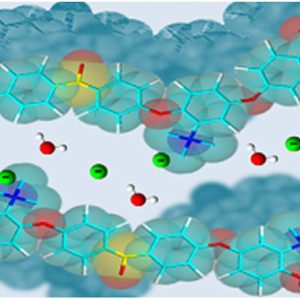Abstract
The effective mobility of hydroxide, chloride and fluoride ions is reported in various anion exchange membranes (AEM) with a backbone of polysulfone (PSU) or poly (2,6-dimethyl-1,4-phenylene)oxide (PPO). The concentration dependence of the effective mobility is used to derive the porosity (π), tortuosity (τ), and percolation thresholds and to plot the ionic conductivity vs the hydration number. Semi-logarithmic plots of the effective ion mobility u(i) vs the square root of concentration √c(i) for hydroxide, fluoride and chloride ions in various PSUand PPO-based ionomers at 25 and 60 °C show linear relations, from which the ratio π/τ can be determined. This existence of linear u(i) = f(√c(i)) plots is related to the very particular boundary conditions experienced by mobile ions, migrating in close vicinity to the immobile grafted counter-ions placed at the interfaces between polymer domains and electrolyte solution. The π/τ values for PSU-QA (0.29) and PPO-QA (0.38) are consistent with a relatively low hydrophilic-hydrophobic nanophase separation, which leads to channels with low diameter and high tortuosity. The tortuosity determined from a Bruggeman-type relation is 1.9 for PSU-QA and 1.6 for PPO-QA. The percolation thresholds φH2O,p, determined from the universal percolation equation near and above φH2O,p, are at a water volume fraction of 0.07 for PSU-TMA and 0.03 for PPO-QA indicating that these AEM have a two-dimensional structure of the hydrated domains. The prefactor, which should represent a good indication as to the maximum achievable ionic conductivity, is slightly below 100 mS/cm for both PSU-TMA and PPO-based ionomers. Plots of experimental and computed hydroxide and chloride ion conductivities as function of the hydration number (λ) show a maximum ionic conductivity for a value of the hydration number around 60, corresponding to optimal hydration conditions. At λ = 100, the ratio of conductivity between PSU-QA (OH– form) and PPO-QA (Cl– form) indicates that the degree of dissociation of ion pairs is about 30% lower for hydroxide than for chloride ions, which is consistent with the effective ionic radii of Cl– and OH– .
Illustrations
Details
Published on: Journal of Membrane Science 617 (2021) 118622
Authors: P. Knauth, L. Pasquini, R. Narducci, E. Sgreccia, R.-A. Becerra-Arciniegas, M.L. Di Vona
